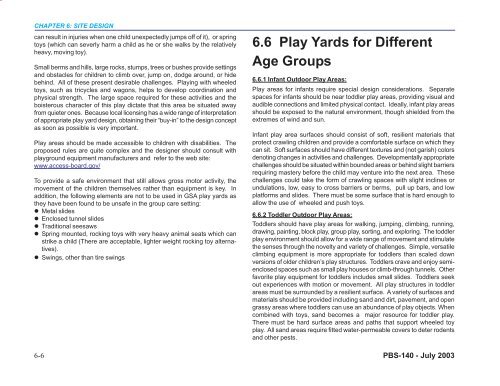PBS 140 Child Care Center Design Guide - The Whole Building ...
PBS 140 Child Care Center Design Guide - The Whole Building ...
PBS 140 Child Care Center Design Guide - The Whole Building ...
Create successful ePaper yourself
Turn your PDF publications into a flip-book with our unique Google optimized e-Paper software.
CHAPTER 6: SITE DESIGN<br />
can result in injuries when one child unexpectedly jumps off of it), or spring<br />
toys (which can severly harm a child as he or she walks by the relatively<br />
heavy, moving toy).<br />
Small berms and hills, large rocks, stumps, trees or bushes provide settings<br />
and obstacles for children to climb over, jump on, dodge around, or hide<br />
behind. All of these present desirable challenges. Playing with wheeled<br />
toys, such as tricycles and wagons, helps to develop coordination and<br />
physical strength. <strong>The</strong> large space required for these activities and the<br />
boisterous character of this play dictate that this area be situated away<br />
from quieter ones. Because local licensing has a wide range of interpretation<br />
of appropriate play yard design, obtaining their “buy-in” to the design concept<br />
as soon as possible is very important.<br />
Play areas should be made accessible to children with disabilities. <strong>The</strong><br />
proposed rules are quite complex and the designer should consult with<br />
playground equipment manufacturers and refer to the web site:<br />
www.access-board.gov/<br />
To provide a safe environment that still allows gross motor activity, the<br />
movement of the children themselves rather than equipment is key. In<br />
addition, the following elements are not to be used in GSA play yards as<br />
they have been found to be unsafe in the group care setting:<br />
� Metal slides<br />
� Enclosed tunnel slides<br />
� Traditional seesaws<br />
� Spring mounted, rocking toys with very heavy animal seats which can<br />
strike a child (<strong>The</strong>re are acceptable, lighter weight rocking toy alternatives).<br />
� Swings, other than tire swings<br />
6-6<br />
6.6 Play Yards for Different<br />
Age Groups<br />
6.6.1 Infant Outdoor Play Areas:<br />
Play areas for infants require special design considerations. Separate<br />
spaces for infants should be near toddler play areas, providing visual and<br />
audible connections and limited physical contact. Ideally, infant play areas<br />
should be exposed to the natural environment, though shielded from the<br />
extremes of wind and sun.<br />
Infant play area surfaces should consist of soft, resilient materials that<br />
protect crawling children and provide a comfortable surface on which they<br />
can sit. Soft surfaces should have different textures and (not garish) colors<br />
denoting changes in activities and challenges. Developmentally appropriate<br />
challenges should be situated within bounded areas or behind slight barriers<br />
requiring mastery before the child may venture into the next area. <strong>The</strong>se<br />
challenges could take the form of crawling spaces with slight inclines or<br />
undulations, low, easy to cross barriers or berms, pull up bars, and low<br />
platforms and slides. <strong>The</strong>re must be some surface that is hard enough to<br />
allow the use of wheeled and push toys.<br />
6.6.2 Toddler Outdoor Play Areas:<br />
Toddlers should have play areas for walking, jumping, climbing, running,<br />
drawing, painting, block play, group play, sorting, and exploring. <strong>The</strong> toddler<br />
play environment should allow for a wide range of movement and stimulate<br />
the senses through the novelty and variety of challenges. Simple, versatile<br />
climbing equipment is more appropriate for toddlers than scaled down<br />
versions of older children’s play structures. Toddlers crave and enjoy semienclosed<br />
spaces such as small play houses or climb-through tunnels. Other<br />
favorite play equipment for toddlers includes small slides. Toddlers seek<br />
out experiences with motion or movement. All play structures in toddler<br />
areas must be surrounded by a resilient surface. A variety of surfaces and<br />
materials should be provided including sand and dirt, pavement, and open<br />
grassy areas where toddlers can use an abundance of play objects. When<br />
combined with toys, sand becomes a major resource for toddler play.<br />
<strong>The</strong>re must be hard surface areas and paths that support wheeled toy<br />
play. All sand areas require fitted water-permeable covers to deter rodents<br />
and other pests.<br />
<strong>PBS</strong>-<strong>140</strong> - July 2003

















